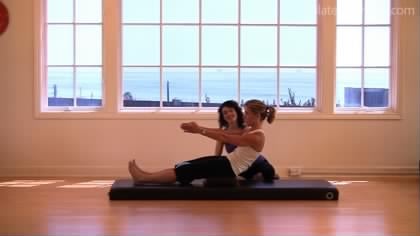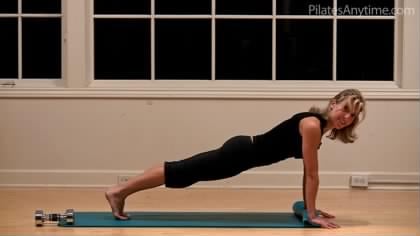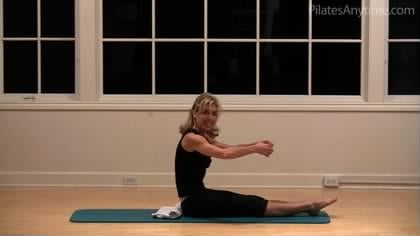Description
About This Video
Transcript
Read Full Transcript
Why the Box is Not Listed as a Prop on Pilates Anytime
Hi I'm Kristi Cooper, and we're just wrapping up after a class. Before I went home I thought, I'm going to try and address a question that I get in the forums quite often. The question is one version of, why didn't you tell me there was going to be a reformer box in the reformer class, and why don't you list it as a prop? I almost did at one point because I do realize that a lot of the home reformers do not offer a box as part of the package. You have to pay extra for that. I did not list it as a prop because in fact, the box is part of the reformer. I think to most people's mind-- who learned on a studio reformer-- it's like the straps. You wouldn't have a reformer without the straps, you wouldn't have a reformer without the box.
The original repertoire uses the box in the most beginning of classes. So that's why I didn't make it a prop. Having said that, I also know how frustrating it can be that you're in the middle of a great class and all of sudden the instructor goes to get the box and you don't have one. So what are you to do? What I want to do, is-- now that I've told you why I don't list it as a prop-- I want to give you some suggestions and alternatives for the most common of exercises. Meaning the ones that are usually in the beginning, intermediate, and sometimes even advance programs. That's what I'm going to do. I'm going to kind of wing it here a little bit because there's so many things you can do. I think the most important part, is that you have some idea of what is the exercise for. My teacher Rael would have us identify the objective of the exercise. Why am I doing it? So if you can get your head around that, you can start to create, or we can take some of these hopefully for you. So hopefully, there'll be some ideas that you can use. I'll do different levels, and I'll probably think of new ones and probably forget the ones I mean to do, so let's just see what we come up with.
Pulling Straps with the Box
I'm going to start by using the box just to quickly demo the exercises we have to replace since you don't have one. Early in the reformer programs you're going to see the long box. That's this position, and the exercise is pulling straps. That comes on pretty early. So normally we'd have a light spring on-- or one red spring. You're lying on the reformer with your straps. We tend to wrap when we have the cords. If you have leather, they usually don't. And the exercise is for your back extensors, your lats, your back basically. Exhaling to pull back. And there's going to different variations. I just want to give you the essence of it, so when you see pulling straps-- some version of it-- whether you start down, or you don't move through the exercise, that's going to be up to the instructor. So listen to them. But for the main point, you're working your back extensors. OK, great. Well I don't have a box. I have a reformer though.
Pulling Straps without the Box
Let's get rid of the box and come up with a way to simulate that. I'm going to start with the easiest first. Not everyone has a reformer that's lifted off the ground like this. A lot of them are a little bit lower. So I'm just going to move to the floor for some easy options for you. I'm thinking of that same exercise. One option is to come face down, reach for your straps, you can time it right along with class. There's usually an inhale perhaps. Exhale to bend as I lift and extend. Now when you have those straps, you're reaching strong and then you come back down. The real only difference here, is that I have to bend my elbows to clear. Other than that, you can follow your instructor's cues. Pulling straps. That's one way to do that one. Another way truly, is just to keep the arms back. Imagine the straps are already there. That's another way. Long time to be there. It's just an idea.
Making it a little more advanced, you could probably do this even with a lower reformer. Not everyone has that height. I'm going to pretend there's a box. I've got to go lighter because I can't do it with both arms. I was on one red, I'm going to lower it down to one blue. And I'm going to be careful. So here I am, I'm going to place one hand at the shoulder rest. My knees are just going to be underneath me. I'm imagining the box. My legs are going to be irrelevant to this particular exercise. From there-- and I've got to be near the edge because we want the arm outside the frame. I'm now listening to my instructor. Stabilizing both shoulders, my back is flat, I'm looking down, I'm going to initiate with the shoulder blade to bring it up. Inhale to bring it back. The good part is it's a little harder than you would be doing it on a box. So you've got to be careful with that. But you're also getting to work unilaterally. You're getting to work one side-- or a cross crawl pattern-- which is great for the body. Make sure you do the other side and just be careful with it. You've always just got to test your control.
Giving you another option-- of course I already did the other side in coming up with them. This is a little more advanced to make it simulated. Remember we're working the lats. We're working our back extensors. I'm going to turn around and put my hands on the foot bar. But I've got to take the spring off for this to work. Otherwise I'm going to be pushing, and it changes the focus. Changes the objective. So I'll find where I want my feet, mostly just relaxed. I'm going to stabilize and get rid of this spring. Oh boy, it's a whole different world when you get rid of it, so you've got to be very careful if you choose to do this.
This is for your advanced people without a box. I'm going to initiate again with my shoulder blades, as if I was going to pull a strap. But in fact, it's going to propel me away from the foot bar. Oh, that's as far as I can go. And now you can see me shaking. I'm going to drag myself forward. It's not with my hands, that's why I left them loose for you to see that. It is, in fact, my lats. Oh, that's it. And then you don't want the legs to do anything. Don't push them forward, it's just way too easy. I'm using the back extensors. I could even add that little bit of lift, pretending the box is under my abs. Oh, this is going to be my last one. This is too hard. You're going to wish you had a box. Careful coming off. Stabilize it, put a spring back on at least. OK, so that's that exercise.
Breaststroke with the Box
Since I'm here, I'm going to keep in that theme. Whenever you see someone doing a prone exercise, you can go, hmm what other alternative? I'll put the box back on and show you breast stroke. This wouldn't come right early in the workout, but it does come in once you've practiced 10, 20, 30 sessions. A red spring is normal. Blue could be good. I should probably drop it, but I'm not going to. This is just a quick showing of breast stroke, so you can see how I'm going to adapt it without a box. Forearms right by your shoulders, same deal with the shoulder blades initiating. Inhale. Again, you'll listen to your instructor's cues for the exact breath patterning and how they do it. Everyone mixes things up. Wonderful exercise, and I'm going to tell you, I even like it sometimes better without the box. So here's how we do that.
Breaststroke without the Box
Easiest thing I think for this one is to go to the floor. I do this one in mat class all the time. You just saw the exercise, you move flat, inhale, all the way around and down. That's it. It's exactly the same. To challenge it, you stay low initially. You really work those external rotators. Now lift as you come around, keeping the feet on the ground. The way I like to challenge it-- because it feels a little contrived to be honest, to do it that way-- I like to make it harder by reversing the direction. So if I'm here, I'm going to keep my body low. To really work the external rotators of the shoulders, I've got to lift the elbows a little. Then I lift. That's where I get really heavy and down. Drag it back around to the back and in. Now what I'm not talking about, is the level of these exercises in particular. Just trying to give you something to spark your creativity-- or your memory-- when you are given breast stroke. You won't be given that in your more beginning classes. What else can I show you?
Backstroke without the Box
Back stroke and teaser if you know it. Normally on the box I would have straps. I'm not even going to show you that part of it. Just to give you a sense, I would have straps here. Carriage would move, right around here it would. And you come back in. I think you see where I'm going to go with this one. This is quite easy to do without the box. You would simply do it on the reformer bed. You could do it on the floor too if you want more room, if you feel like your shoulder rests are in the way. Scoot away from your shoulder rests. Kind of a nice marker. They're narrow there because you can know if you're falling back, which is what you don't want to do. You'll be curled up nice and high pretending you have those straps. That's really all we need. They're not heavy. You go straight up, turn it around. Listen to your instructor here, everyone finishes differently there and in. Body doesn't move, that's the point. So I don't have to be hanging off a box for that one.
Teaser without the Box
The teaser. That one's a little different. But you can do it here just as easily. Stretched out legs-- this is the more classical version-- arms in the T, body ready to go, you're going to roll up into your teaser. Nice and tall. Now normally, you'd move the arms, so the carriage is going back and forth. I might just move the legs a little. Because you're testing the balance, so it's the objective. You don't have to do the same thing, you have to achieve the same thing. And then down. And then follow your instructor on that. Easy to do without a box. No excuses. What else? I'm looking at my cheat sheet over here for what else we do on the box.
Short Box Series without the Box
Short box series. I'm not going to do the whole thing because it's so easy to do on the floor. But I did find a new way of doing it, which I really enjoy. Something for you think about. Short box ordinarily-- I guess I'll show it to you-- just one tiny bit of it so you know what I'm referring to. On a Gratz. The box is a little smaller. You would cover the shoulder rest almost across the board. The balance body boxes are a little bigger, I'm a little shorter, this works better for me to keep the box in front. So that's what you're seeing that. Then you have your feet under a strap. There's a lot of detail with that that I'm not going into, but you're in this position. Your legs are strong, you're working your trunk, your powerhouse. So that's where I'm basing it from. Now if I just move it to the floor, it can be a lot of work that the hip flexors aren't prepared for because now you got to sit up straight. You're going to take yourself out of that position into the round back, the flat back, the tilt, the twist, those are exercises that come with it. But what I've discovered-- I shouldn't say I, I'm sure I stole it from someone-- don't we all?
Anyway, I've got-- this is Michael and Ton's Triadball-- an over-ball would work, probably a towel would work, give it a shot-- to wedge it. It's there. Then it just takes a little-- I'm not resting on it-- there's a difference-- but I can feel it. It's giving me just a hint of support that allows my hip flexors in this position to draw down energy a little bit. It's not gripping as much as I could be. And then from there you just carry on. I actually love this. I just discovered this tonight, for myself anyway. So I'm pushing in. That's what you'd be doing with your feet under the straps. But it's not this-- they're working-- but it's not this upward pull. Now you think, well that's no good because I see them go over the back. But you can. I've done my round back. If the ball is big enough, and if you're not sure you just put your hands down. A little support, I got to tell you it's divine. And then curl back up. And there you go. What you don't want to do-- just so I make a point-- is lift from here. You got to do it sequentially just like you would on the reformer. Chin to chest. You're following the exact same queues, you just have to be on the floor. You could do it right here too by the way. You may even have the strap. I'd be careful about using the strap if you don't have a box. I would just do as I'm doing it, with a towel or something right there. Be careful of the shoulder rest. Flat back, it all works the same. I don't need to go through them all because your teacher will show you that. But it's nice. For you mat teachers, you're going to like that, I think. That's short box.
Climb a Tree without the Box
Oh, fun one. I will show you this one. Climb a tree. With the ball, you have to have a bigger one like this if you want to do it exactly as I'm doing it-- but if it's a nice connection that I was playing with earlier. I'm showing the BASI version. It's not that different though. Where we would just be nice and tall, we do three little pumps. I've got this connection of my hamstring to the ball. Then as I go back-- and I could have started with this knee bent-- I'm going to extend the leg and squeeze the ball between the two. It's not perfectly centered, it doesn't have to be. If it falls, you fix it. But here I am now. I have this sense of mid-line as I bring it back. The challenge now, is I want to straighten the leg, but I can't drop the ball. So I hold it between the inner thighs, take it around, you can play with how high you take that leg, and then maybe bring it in again. And carry on. It's really lovely. Really lovely. You can play with that, but you don't need a ball at all for any of these. I also do these in class where I don't go all the way down. La, la, la, la. OK.
The box is brilliant, I think everyone should have one. I'm going to tell you, if you're doing Pilates and you're using a reformer, you should have a box. But if you don't have a box, it's OK, you still do the work. But get the box. OK. Short box, what else do we do on the short box?
Side Overs without the Box
Side overs. I'm here. I'll stay here. Side overs normally done on the box sitting like so. Now we can take it over. I usually don't. Again, because of my height. Feels better without. Foot is under the strap. Lovely exercise. Final version is either here or here. Reaching down, reaching up. Reaching down, reaching up. Objective? Oblique without a doubt. OK we don't have a box though, so what might I do? Well if I were on the floor like I was a moment ago, I can take this ball-- and you play where you put it. It really changes the emphasis, but it's all basically the same. I think it's going to feel a little easier when it's riding close to you first. You're reaching this leg. The good news is you've got to work without a strap. So you might be working harder. Your range will be smaller, you just got to know that going in. So getting used to it, you're over the ball, kind of feel for it. Where are you? You got to pay attention to yourself, knowing what the objective is, obliques. Side bending, no twisting. I'm not sure. I'm going to go down, and I'm just going to imagine someone pulling me up. So I'm imagining someone's got this hand, and I'm coming up. Oh, I want to go higher, but I just can't. That's one thing. You could wrap it around your waist. That's making me heavier. Up and down. And I'm just sliding up and my hand here is guiding me so I don't roll back. It just lets me know.
If you really want to get crazy, you can either stay where was or move the ball up a little. And take the whole thing and get nowhere. Boom. Or keep it high and have a bigger range. But then you deal with the balance and the weight. It looks just the same, doesn't it? Anyway you can play with it. They're all good and doing the same exercise. And about the same timing too. It's a freighter. [TRAIN WHISTLE] Oh yeah. OK. So then let's just keep this. Because I have to admit that was a little unsatisfying in terms of the range of motion. I got the job done-- so I'd be happy with it-- but it just feels hard. Let's pretend it's a book. A big book. A phone book. Who has those anymore I don't know, but that's what we say because that's what we used to use. So what we're going to do is elevate ourselves so that we can have range of motion. So what I'm going to do, is just set the box down. I need a wall. You can do something on the reformer, I'll show you in a second a couple things.
Side Overs with a Moonbox
But for now, I'm sitting on the moon box or something elevated. It doesn't even have to be this high. Don't worry about that. Very similar position to that I was just in. And here's the trick. I'm pushing into the wall-- or in this case the reformer-- and that's my anchor point. I've got to move myself out a tiny bit more. Procrastinating can you tell? OK. Getting a feel for it. I'm not sure if I'm going to get back up, so I'm going to make sure. This might be way harder than doing it with a strap. The only reason I'm not falling off the box is because of my energy reaching into the leg of the reformer. Just to give you another view, and to even out a little. Pushing in, not so much that I move the reformer because then the rest of me is going the other way. Sitting sideways, and-- Nothing's hooked. It's the dispersion of energy. That's half of what Pilates is, maybe all of it. OK? That's that.
You could also-- if you were on the reformer, didn't want to get on your floor-- you could do it here. And this might even give you a better stretch. I'm doing the exact same stuff. I'm pushing into the ground. But now I've got this downward slope so I'm going to get a better stretch. People will teach it vertical like so, perfectly fine. Or you could start off to the side and never catch a break. Again, listen to your teacher. Just reaching into the wall as I go over. Oh, is that leg working, but so are my obliques. Reaching into the wall, find a place that's pretty comfortable. If you're going to do the vertical version, you'll be right up on your bum. If not, you'll be on the side of your hip. Oh, the hard side. I tell you, that is as good as it gets. Just not quite as stretchy. OK. So that's another way no box. There's probably 100 different ways to do these things. But if you know what you're trying to achieve, you've got options.
Side Bend Substitute for Side Overs
One more. It's just trying to get the sensation of it. What I would do is have my bar up. Pretty high, I think probably as high as possible. No matter who you are, or how tall you are, but I'm not totally sure about that. I'm saying that, and I actually played with it. Yeah, that's good. That's probably really good. Oh, it's going to be hard. A light spring for this. I think a blue. You want a spring though. Don't take all the springs off. It's always a good idea to test it with heavier than you think it might be. Safer, right? Oh, it's light. I'm trying to stimulate the stretch of the side over with the work to come back up. This is what I'm talking about. So what I'm going to do, is I'm going to push myself out trying to keep my knees with my hips for as long as I can. I'm going to bring my feet a little closer. I do it two ways. I'm going to do this version. Bringing in your legs a little closer. I'm going to lean into it just a little. I have a bit more weight on what looks like my left leg. Then the good part. From the obliques-- from the waist, not from the hips-- I'm going to side bend. I'm not letting the elbow bend to do the side. And then I just come out. I side bend, over, over, over, and out. Side bend, you could get really crazy with it and come into a lean where this leg isn't doing m but might as well leave it there. And then in and up, and side bend. Keep that arm straight. Don't twist back away from me there. I just caught myself doing that. Might back out a little bit more. And out. And out. Not a bad star prep, I don't think. Working on that.
Depending on how high your bar is in relation to you, you just want to be where you can have a straight arm. I think I had to move out, didn't I? I do some-- not a lot-- but pressure into my shin so it's not all into my kneecap. And then I'm just using the left lat to push me out a bit. Trying to keep the weight equal on the knees for at least the first few. Side bending, and then we brought the waist in, and up, and back out. In and up and back out. You can start opening it up if you want to get a little bit longer. Now unlike what this position would be if you were hooked under the strap for side overs, this is the easy part. And you change the emphasis and make the hard part here. You're getting a stretch here now, but this is where the work's happening. Unlike it was when you were doing it the normal way. OK? I like that one. It's not super fabulous on the knees if you don't like that kind of pressure, but otherwise it's great exercise.
Understanding the Purpose of the Exercise
There's more exercises on the box that are used on the reformer, but those are really the most common ones. What I'm hoping that you're taking away from this, is to rather than see your equipment as a necessary must in order to get that exercise, try and start evaluating why the instructor is giving it to you. If the answer is because Joseph gave it to them down the line, then why? Because as soon as you get a sense of that, you will know you can do any number of things, even a basic thing. The worst thing is having to just stop, and sit, and break the flow. I know how frustrating that is. Hopefully these gave you some ideas. If you've got a big physio ball, imagine. You could do all sorts of things with that. Play with it, and certainly keep asking questions.
If there's a specific exercise, don't hesitate to ask either myself, or the instructor who taught it. That's probably the best place to go because they know why they're doing it. Thank you for your patience too. We're doing the best we can with making sure you understand what we're doing when we say reformer class, but about 95% of our classes do have a box. Because the box comes with the reformer. If you're going to do Pilates, at least know that. But know that you have lots of play within the whole repertoire. Thank you.
The Successful Beginner - Playlist 2: Modifications for Classes
Comments

 Anyway, thanks for making the connection and for watching.
Anyway, thanks for making the connection and for watching.
You need to be a subscriber to post a comment.
Please Log In or Create an Account to start your free trial.

























